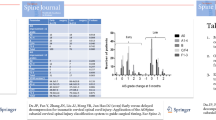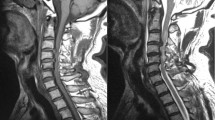Abstract
Purpose
The objective of this study is to investigate whether preexisting severe cervical spinal cord compression affects the severity of paralysis once patients develop traumatic cervical spinal cord injury (CSCI) without bone injury.
Methods
We retrospectively investigated 122 consecutive patients with traumatic CSCI without bone injury. The severity of paralysis on admission was assessed by the American Spinal Injury Association impairment scale (AIS). The degree of preexisting cervical spinal cord compression was evaluated by the maximum spinal cord compression (MSCC) and was divided into three categories: minor compression (MSCC ≤ 20 %), moderate compression (20 % < MSCC ≤ 40 %), and severe compression (40 % < MSCC). We investigated soft-tissue damage on magnetic resonance imaging to estimate the external force applied. Other potential risk factors, including age, sex, fused vertebra, and ossification of longitudinal ligament, were also reviewed. A multivariate logistic regression analysis was performed to investigate the risk factors for developing severe paralysis (AIS A–C) on admission.
Results
Our study included 103 males and 19 females with mean age of 65 years. Sixty-one patients showed severe paralysis (AIS A–C) on admission. The average MSCC was 22 %. Moderate compression was observed in 41, and severe in 20. Soft-tissue damage was observed in 91. A multivariate analysis showed that severe cervical spinal cord compression significantly affected the severity of paralysis at the time of injury, whereas both mild and moderate compression did not affect it. Soft-tissue damage was also significantly associated with severe paralysis on admission.
Conclusions
Preexisting severe cervical cord compression is an independent risk factor for severe paralysis once patients develop traumatic CSCI without bone injury.


Similar content being viewed by others
References
Koyanagi I, Iwasaki Y, Hida K, Akino M, Imamura H, Abe H (2000) Acute cervical cord injury without fracture or dislocation of the spinal column. J Neurosurg 93:15–20
Sakai H, Ueta T, Shiba K (2010) Current situation of medical care for spinal cord injury in Japan (in Japanese). J Spine Res 1:41–51
El Masri WS, Kumar N (2011) Traumatic spinal cord injuries. Lancet 377:972–974. doi:10.1016/s0140-6736(11)60248-1
Kawano O, Maeda T, Mori E, Yugue I, Takao T, Sakai H, Ueta T, Shiba K (2014) Influence of spinal cord compression and traumatic force on the severity of cervical spinal cord injury associated with ossification of the posterior longitudinal ligament. Spine (Phila Pa 1976). doi:10.1097/brs.0000000000000361
Kato H, Kimura A, Sasaki R, Kaneko N, Takeda M, Hagiwara A, Ogura S, Mizoguchi T, Matsuoka T, Ono H, Matsuura K, Matsushima K, Kushimoto S, Fuse A, Nakatani T, Iwase M, Fudoji J, Kasai T (2008) Cervical spinal cord injury without bony injury: a multicenter retrospective study of emergency and critical care centers in Japan. J Trauma 65:373–379. doi:10.1097/TA.0b013e31817db11d
Takao T, Morishita Y, Okada S, Maeda T, Katoh F, Ueta T, Mori E, Yugue I, Kawano O, Shiba K (2013) Clinical relationship between cervical spinal canal stenosis and traumatic cervical spinal cord injury without major fracture or dislocation. Eur Spine J. doi:10.1007/s00586-013-2865-7
Wilson JR, Cadotte DW, Fehlings MG (2012) Clinical predictors of neurological outcome, functional status, and survival after traumatic spinal cord injury: a systematic review. J Neurosurg Spine 17:11–26. doi:10.3171/2012.4.aospine1245
Aebli N, Ruegg TB, Wicki AG, Petrou N, Krebs J (2013) Predicting the risk and severity of acute spinal cord injury after a minor trauma to the cervical spine. Spine J 13:597–604. doi:10.1016/j.spinee.2013.02.006
Chikuda H, Seichi A, Takeshita K, Matsunaga S, Watanabe M, Nakagawa Y, Oshima K, Sasao Y, Tokuhashi Y, Nakahara S, Endo K, Uchida K, Takahata M, Yokoyama T, Yamada K, Nohara Y, Imagama S, Hosoe H, Ohtsu H, Kawaguchi H, Toyama Y, Nakamura K (2011) Acute cervical spinal cord injury complicated by preexisting ossification of the posterior longitudinal ligament: a multicenter study. Spine (Phila Pa 1976) 36:1453–1458. doi:10.1097/BRS.0b013e3181f49718
Okada S, Maeda T, Ohkawa Y, Harimaya K, Saiwai H, Kumamaru H, Matsumoto Y, Doi T, Ueta T, Shiba K, Iwamoto Y (2009) Does ossification of the posterior longitudinal ligament affect the neurological outcome after traumatic cervical cord injury? Spine (Phila Pa 1976) 34:1148–1152. doi:10.1097/BRS.0b013e31819e3215
Maeda T, Ueta T, Mori E, Yugue I, Kawano O, Takao T, Sakai H, Okada S, Shiba K (2012) Soft-tissue damage and segmental instability in adult patients with cervical spinal cord injury without major bone injury. Spine (Phila Pa 1976) 37:E1560–E1566. doi:10.1097/BRS.0b013e318272f345
Maynard FM Jr, Bracken MB, Creasey G, Ditunno JF Jr, Donovan WH, Ducker TB, Garber SL, Marino RJ, Stover SL, Tator CH, Waters RL, Wilberger JE, Young W (1997) International standards for neurological and functional classification of spinal cord injury. Am Spinal Inj Assoc Spinal Cord 35:266–274
Rao SC, Fehlings MG (1999) The optimal radiologic method for assessing spinal canal compromise and cord compression in patients with cervical spinal cord injury. Part I: An evidence-based analysis of the published literature. Spine (Phila Pa 1976) 24:598–604
Fehlings MG, Furlan JC, Massicotte EM, Arnold P, Aarabi B, Harrop J, Anderson DG, Bono CM, Dvorak M, Fisher C, France J, Hedlund R, Madrazo I, Nockels R, Rampersaud R, Rechtine G, Vaccaro AR (2006) Interobserver and intraobserver reliability of maximum canal compromise and spinal cord compression for evaluation of acute traumatic cervical spinal cord injury. Spine (Phila Pa 1976) 31:1719–1725. doi:10.1097/01.brs.0000224164.43912.e6
Furlan JC, Fehlings MG, Massicotte EM, Aarabi B, Vaccaro AR, Bono CM, Madrazo I, Villanueva C, Grauer JN, Mikulis D (2007) A quantitative and reproducible method to assess cord compression and canal stenosis after cervical spine trauma: a study of interrater and intrarater reliability. Spine (Phila Pa 1976) 32:2083–2091. doi:10.1097/BRS.0b013e318145a91c
Kongsted A, Sorensen JS, Andersen H, Keseler B, Jensen TS, Bendix T (2008) Are early MRI findings correlated with long-lasting symptoms following whiplash injury? A prospective trial with 1-year follow-up. Eur Spine J 17:996–1005. doi:10.1007/s00586-008-0687-9
Machino M, Yukawa Y, Ito K, Nakashima H, Kanbara S, Morita D, Kato F (2011) Can magnetic resonance imaging reflect the prognosis in patients of cervical spinal cord injury without radiographic abnormality? Spine (Phila Pa 1976) 36:E1568–E1572. doi:10.1097/BRS.0b013e31821273c0
Miyanji F, Furlan JC, Aarabi B, Arnold PM, Fehlings MG (2007) Acute cervical traumatic spinal cord injury: MR imaging findings correlated with neurologic outcome–prospective study with 100 consecutive patients. Radiology 243:820–827. doi:10.1148/radiol.2433060583
Song KJ, Kim GH, Lee KB (2008) The efficacy of the modified classification system of soft tissue injury in extension injury of the lower cervical spine. Spine (Phila Pa 1976) 33:E488–E493. doi:10.1097/BRS.0b013e31817b6191
Hayashi K, Yone K, Ito H, Yanase M, Sakou T (1995) MRI findings in patients with a cervical spinal cord injury who do not show radiographic evidence of a fracture or dislocation. Paraplegia 33:212–215. doi:10.1038/sc.1995.47
Wu JC, Ko CC, Yen YS, Huang WC, Chen YC, Liu L, Tu TH, Lo SS, Cheng H (2013) Epidemiology of cervical spondylotic myelopathy and its risk of causing spinal cord injury: a national cohort study. Neurosurg Focus 35:E10. doi:10.3171/2013.4.focus13122
Author information
Authors and Affiliations
Corresponding author
Ethics declarations
Conflict of interest
The authors report no conflict of interest concerning the materials or methods used in this study or the findings specified in this paper.
Rights and permissions
About this article
Cite this article
Oichi, T., Oshima, Y., Okazaki, R. et al. Preexisting severe cervical spinal cord compression is a significant risk factor for severe paralysis development in patients with traumatic cervical spinal cord injury without bone injury: a retrospective cohort study. Eur Spine J 25, 96–102 (2016). https://doi.org/10.1007/s00586-015-4142-4
Received:
Revised:
Accepted:
Published:
Issue Date:
DOI: https://doi.org/10.1007/s00586-015-4142-4




